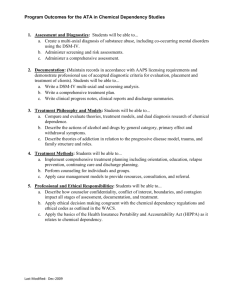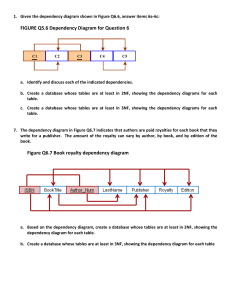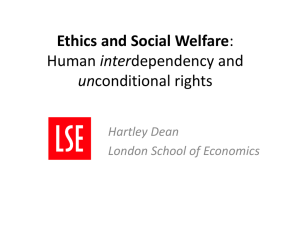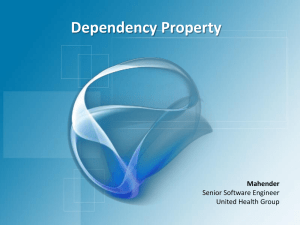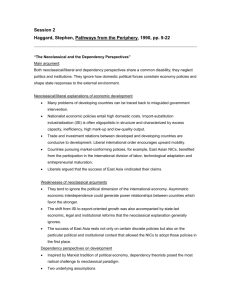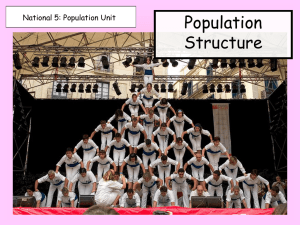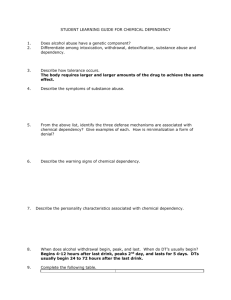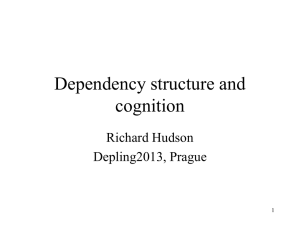Generating Typed Dependency Parses from Phrase Structure P
advertisement
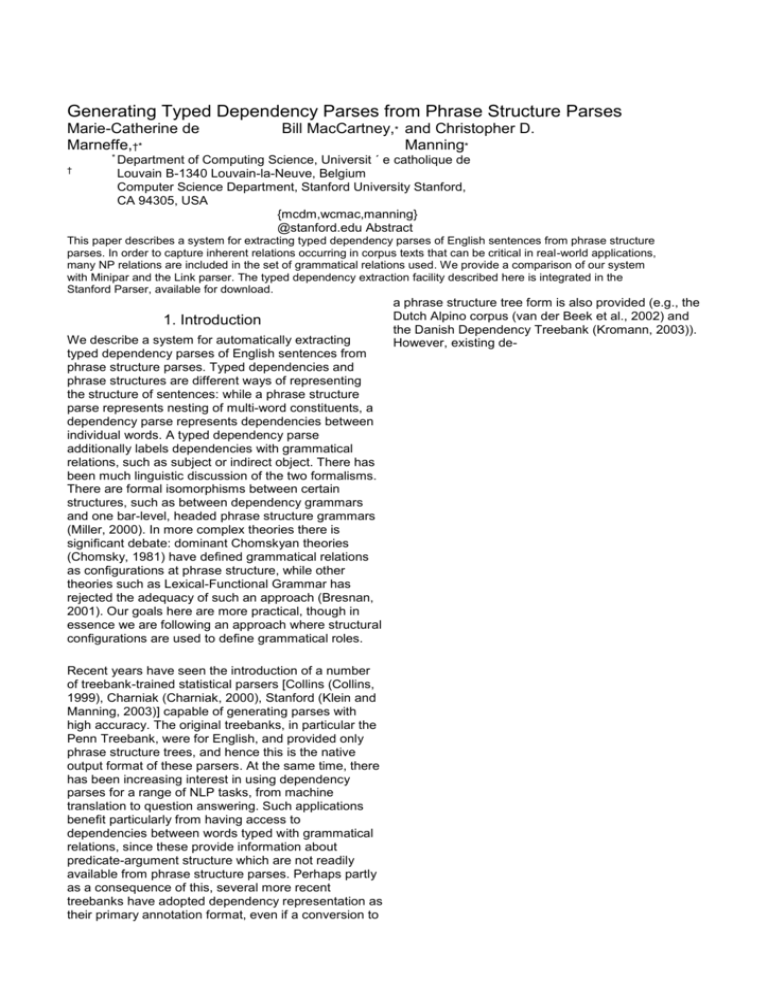
Generating Typed Dependency Parses from Phrase Structure Parses
Marie-Catherine de
Marneffe,†*
†
Bill MacCartney,* and Christopher D.
Manning*
* Department
of Computing Science, Universit ´ e catholique de
Louvain B-1340 Louvain-la-Neuve, Belgium
Computer Science Department, Stanford University Stanford,
CA 94305, USA
{mcdm,wcmac,manning}
@stanford.edu Abstract
This paper describes a system for extracting typed dependency parses of English sentences from phrase structure
parses. In order to capture inherent relations occurring in corpus texts that can be critical in real-world applications,
many NP relations are included in the set of grammatical relations used. We provide a comparison of our system
with Minipar and the Link parser. The typed dependency extraction facility described here is integrated in the
Stanford Parser, available for download.
1. Introduction
We describe a system for automatically extracting
typed dependency parses of English sentences from
phrase structure parses. Typed dependencies and
phrase structures are different ways of representing
the structure of sentences: while a phrase structure
parse represents nesting of multi-word constituents, a
dependency parse represents dependencies between
individual words. A typed dependency parse
additionally labels dependencies with grammatical
relations, such as subject or indirect object. There has
been much linguistic discussion of the two formalisms.
There are formal isomorphisms between certain
structures, such as between dependency grammars
and one bar-level, headed phrase structure grammars
(Miller, 2000). In more complex theories there is
significant debate: dominant Chomskyan theories
(Chomsky, 1981) have defined grammatical relations
as configurations at phrase structure, while other
theories such as Lexical-Functional Grammar has
rejected the adequacy of such an approach (Bresnan,
2001). Our goals here are more practical, though in
essence we are following an approach where structural
configurations are used to define grammatical roles.
Recent years have seen the introduction of a number
of treebank-trained statistical parsers [Collins (Collins,
1999), Charniak (Charniak, 2000), Stanford (Klein and
Manning, 2003)] capable of generating parses with
high accuracy. The original treebanks, in particular the
Penn Treebank, were for English, and provided only
phrase structure trees, and hence this is the native
output format of these parsers. At the same time, there
has been increasing interest in using dependency
parses for a range of NLP tasks, from machine
translation to question answering. Such applications
benefit particularly from having access to
dependencies between words typed with grammatical
relations, since these provide information about
predicate-argument structure which are not readily
available from phrase structure parses. Perhaps partly
as a consequence of this, several more recent
treebanks have adopted dependency representation as
their primary annotation format, even if a conversion to
a phrase structure tree form is also provided (e.g., the
Dutch Alpino corpus (van der Beek et al., 2002) and
the Danish Dependency Treebank (Kromann, 2003)).
However, existing de-
pendency parsers for English such as Minipar (Lin,
1998) and the Link Parser (Sleator and Temperley,
1993) are not as robust and accurate as
phrase-structure parsers trained on very large corpora.
The present work remedies this resource gap by
facilitating the rapid extraction of grammatical relations
from phrase structure parses. The extraction uses
rules defined on the phrase structure parses.
2. Grammatical relations
This section presents the grammatical relations output
by our system.
The selection of grammatical relations to include in our
schema was motivated by practical rather than
theoretical concerns. We used as a starting point the
set of grammatical relations defined in (Carroll et al.,
1999) and (King et al., 2003). The grammatical
relations are arranged in a hierarchy, rooted with the
most generic relation, dependent. When the relation
between a head and its dependent can be identified
more precisely, relations further down in the hierarchy
can be used. For example, the dependent relation can
be specialized to aux (auxiliary), arg (argument), or
mod (modifier). The arg relation is further divided into
the subj (subject) relation and the comp (complement)
relation, and so on. The whole hierarchy of our
grammatical relations is given in Figure 2.
Altogether, the hierarchy contains 48 grammatical
relations. While the backbone of the hierarchy is
quite similar to that in (Carroll et al., 1999), over time
we have introduced a number of extensions and
refinements to facilitate use in applications. Many
NP-internal relations play a very minor role in
theoretically motivated frameworks, but are an
inherent part of corpus texts and can be critical in
real-world applications. Therefore, besides the
commonest grammatical relations for NPs (amod adjective modifier, rcmod - relative clause modifier,
det - determiner, partmod - participial modifier,
infmod - infinitival modifier, prep - prepositional
modifier), our hierarchy includes the following
grammatical relations: appos (appositive modifier),
nn (noun compound), num (numeric modifier),
number (element of compound number) and abbrev
(abbreviation). The example sentence “Bills on ports
and immigration were submitted by Senator
Brownback, Republican
B
il
ls
submitted
nsubjpass auxpass
prep
dep - dependent
aux - auxiliary
auxpass - passive
auxiliary cop - copula
conj - conjunct cc coordination arg - argument
nsubjpass - passive nominal subject
csubj - clausal subject
b
y
were
Senator
Republican
subj - subject nsubj nominal subject
appos
comp - complement
obj - object
prep
ports
conj
c
c
a
n
d
immigra
tion
of
pobj
Kansas
Figure 1: An example of a typed dependency parse for
the sentence “Bills on ports and immigration were
submitted by Senator Brownback, Republican of
Kansas.”
of Kansas” in Figure 1 illustrates the appos relation
between “Brownback” and “Republican” and the nn
relation between “Brownback” and “Senator”. The num
relation qualifies a number that serves to modify the
meaning of a NP: num (sheep, 3) in “Sam ate 3
sheep”, whereas the number relation captures the
internal structure of multi-word numbers like number
(5, million) in “I lost 5 million dollars”. The abbrev
relation indicates that MIT is the abbreviation for
“Massachusetts Institute of Technology” in the
following sentence: “The Massachusetts Institute of
Technology (MIT) is located in Boston”. Such
information can be useful in the context of a textual
inference application, as explained below.
3. Extraction method
Our technique for producing typed
dependencies is essentially based on rules –
or patterns – applied on phrase structure
trees. The method is general, but requires
appropriate rules for each language and
treebank representation. Here we present
details only for Penn Treebank English, but
we have also developed a similar process for
Penn Treebank Chinese. The method for
generating typed dependencies has two
phases: dependency extraction and
dependency typing. The dependency
extraction phase is quite simple. First, a
dobj - direct object iobj indirect object pobj object of preposition
sentence is parsed with a phrase structure
grammar parser. Any Penn Treebank parser
could be used for the process described here,
but in practice we are using the Stanford parser
(Klein and Manning, 2003), a highaccuracy
statistical phrase structure parser trained on
the Penn Wall Street Journal Treebank. The
head of each constituent of the sentence is
then identified, using rules akin to the Collins
head rules, but modified to retrieve the
semantic head of the constituent rather than
the syntactic head. While heads chosen for
phrase structure parsing do not really matter,
retrieving sensible heads is crucial for
extracting semantically appropriate
dependencies. For example, in relative
clauses, the Collins rule will choose as head
the
attr - attributive ccomp - clausal complement
with internal subject xcomp - clausal
complement with external subject compl complementizer mark - marker (word
introducing an advcl) rel - relative (word
introducing a rcmod) acomp - adjectival
complement
agent - agent ref referent expl - expletive
(expletive there) mod modifier
advcl - adverbial clause modifier
purpcl - purpose clause modifier
tmod - temporal modifier rcmod relative clause modifier amod adjectival modifier infmod infinitival modifier partmod participial modifier num - numeric
modifier number - element of
compound number appos appositional modifier nn - noun
compound modifier abbrev abbreviation modifier advmod adverbial modifier
neg - negation modifier poss
- possession modifier
possessive - possessive
modifier (’s) prt - phrasal verb
particle det - determiner prep prepositional modifier
sdep - semantic
dependent xsubj controlling subject
Figure 2: The grammatical relation hierarchy.
pronoun introducing the relative clause. As all the
other words in the relative clause will depend on the
head, it makes more sense to choose the verb as
head when determining dependencies. In general,
we prefer content words as heads, and have
auxiliaries, complementizers, etc. be dependents of
them. Another example concerns NPs with
ambiguous structure or multiple heads which are
annotated
with a flat structure in the Penn Treebank:
(NP the new phone book and tour guide)
Using the Collins rule, the head for this example is the
word “guide”, and all the words in the NP depend on it.
In order to find semantically relevant dependencies, we
need to identify two heads, “book” and “guide”. We will
then get the right dependencies (the noun “book” still
has primacy as a governing verb will link to it, but this
seems reasonable):
saw
saw
dobj
dobj
you
man
nsubj
I
rcmod
nsu
bj
ref loves
det
rel nsubj
the
nn (book, phone) nn (guide, tour) CC and (book,
guide) amod (book, new) det (book, the)
who
I
Figure 3: An example of a typed dependency parse for the sentence “I saw the man who loves you”.
It is essential in such cases to determine heads that
will enable us to find the correct dependencies.
In the second phase, we label each of the
dependencies extracted with a grammatical
relation which is as specific as possible. For each
grammatical relation, we define one or more
patterns over the phrase structure parse tree
(using the tree-expression syntax defined by
tregex (Levy and Andrew, 2006)). Conceptually,
each pattern is matched against every tree node,
and the matching pattern with the most specific
grammatical relation is taken as the type of the
dependency (in practice, some optimizations are
used to prune the search).
dobj rcmod
Bills
PREP_on
man
loves
det
ports
CC_and
nsubj
rel
dobj
you
the
who
im
mi
gr
ati
on
nn
submitted
appos
PREP_of
Kansas
nsubjpass auxpass
Up until this point, if one assumes an extra “root” for
the sentence, then each word token is the dependent
of one thing, and the number of typed dependencies in
the representation is the same as the number of words
in the sentence. The dependency graph is a tree (a
singly rooted directed acyclic graph with no
re-entrancies). However, for some applications, it can
be useful to regard some words, such as prepositions
and conjunctions, as themselves expressing a
grammatical relation. This is achieved by collapsing a
pair of typed dependencies into a single typed
dependency, which is then labeled with a name based
on the word between the two dependencies (the word
itself being excised from the dependency graph). This
facility is provided by our system, primarily targeted at
prepositions, conjunctions, and possessive clitics. As
already mentioned, Figure 1 shows the typed
dependency parse obtained for the sentence “Bills on
ports and immigration were submitted by Senator
Brownback, Republican of Kansas.” Figure 5 gives the
typed dependency parse for the same sentence after
the “collapsing” process, where the dependencies
related to the prepositions “on” and “of” have been
collapsed, as well as the conjunct dependencies for
“ports and immigration”. Our system optionally
provides another layer of processing of conjunct
dependencies which aims to produce a representation
closer to the semantics of the sentence. In our
example, this processing will add a PREP on
dependency between “Bills” and “immigration” as
shown in Figure 6. An additional example of
dependency structure modification is in a relative
clause such as “I saw the man who loves you”, the
dependencies ref (man, who) and nsubj(loves, who)
will be extracted, as shown in Figure 3. However it
might be more useful to get nsubj(loves, man)
Figure 4: An example of a typed dependency parse for
the sentence “I saw the man who loves you”, with
“collapsing” turned on.
Direct comparison between our system and other
dependency parsers like Minipar and the Link Parser is
compli-
where the relative pronoun is replaced by its actual
referent. In such case the output will be the one in
Figure 4. Note that as a result of this structure
modification, a dependency graph may actually
become cyclic, as shown in Figure 4. The usefulness
of such structures depends on downstream software
being able to correctly handle cyclic directed graphs.
Figure 5: A dependency parse for the sentence “Bills
on ports and immigration were submitted by Senator
Brownback, Republican of Kansas”, with “collapsing”
turned on.
4. Comparison
Senato
r
wer
e
Republica
n
Brownbac
k
PREP_by
submitted
nsubjpass auxpass
Bills
were
agent
appos
Republic
Brownback an
nn
PREP_on
PREP_on
ports
noun arguments, but doesn’t further distinguish
among these. A mapping of our grammatical
relations into Carroll’s scheme in order to evaluate
our system using Carroll’s Greval test suitewould not
reflect the finer distinctions we make. But often these
finer distinctions drive success in applications. For
example, our PA S C A L Recognizing Textual
Entailment (see Section 5) derives considerable
value from relations such as appos and abbrev.
2or
CC_and
immigrat
ion
Senator
Figure 6: A dependency parse for the sentence “Bills
on ports and immigration were submitted by Senator
Brownback, Republican of Kansas”, with “collapsing”
turned on and processing of the conjunct
dependencies.
cated by differences between the annotation schemes
targeted by each system, presumably reflecting
variation in theoretical and practical motivations. The
differences fall into two main categories: dependency
structure (which pairs of words are in a dependency
relation) and dependency typing (what the grammatical
relation for a particular dependency is).
1First, the systems do not always agree about which
words should be counted as the dependents of a
particular governor. For example, the Link Parser has a
dependency type C which is described as follows: “C
links conjunctions to subjects of subordinate clauses
(“He left W H E N H E saw me”). It also links certain verbs
to subjects of embedded clauses (“He S A I D H E was
sorry”).”This leads the Link Parser to link “that” with
“irregularities” and “said” with “investigation” in
sentence 1 of table 2. In contrast, our system links
subordinating conjunctions with the verb of the clause
and main verbs to the verb of an embedded clause: in
sentence 1, “that” is linked with “took place” (compl
(took place, that)) and “said” with “produced” (
ccomp(said, produced)). Another example regards the
word “below” in sentence 6: the Link parser connects it
with “he”, whereas our system links it with “see”
(advmod (see, Below)).
Moreover, there are differences among the systems
with regard to the “collapsing” of prepositions and
coordination; as discussed above in section 3, we have
tried to handle these in a way that facilitates semantic
analysis.
Even where the systems agree about whether two
words are in a dependency relation, they may diverge
about the type of the dependency. Each system
assigns dependency types from a different set of
grammatical relations, and it is not straightforward to
establish mappings between these sets. Of course, theIn
names used for relations vary considerably, and the contrast,
distinctions between different relations may vary as the Link
well. But the most salient difference between the
Parser
schemes is the level of granularity. As indicated in table
uses a
1, the set of relations defined by Carroll is
very
comparatively coarsegrained. Carroll’s scheme makesfine-graine
a distinction between verb
d set of
1A complete summary of the grammatical relations used by relations,
the Link parser can be found at
which
http://bobo.link.cs.cmu.edu/link/dict/summarize-links.html. often
makes
distinction
s of a
structural
rather
than a
semantic
nature, as
for
example
the MX
relation
which
“connects
modifying
phrases
with
commas
to
preceding
nouns
(“The D O
G,aPOO
D L E , was
black”; “ J
OHN,IN
a black
suit,
looked
great”).”
The Link
Parser
has
specific
relations
for idiomatic expressions. It also has three different
relations for an adverb modifying another adverb, or
an adjective, or a comparative adjective. The Link
Parser uses a different set of dependency types for
dependencies appearing in questions and relative
clauses. We suggest that many of these distinctions
are too fine to be of practical value, and in our system
we have aimed for an intermediate level of granularity,
motivated by the needs of practical applications.
Such differences make it difficult to directly compare
the quality of the three systems. Lin (Lin, 1998)
proposes two ways to evaluate the correctness of a
dependency parse against a gold standard. In the first
method, one simply examines whether each output
dependency also occurs in the gold standard, while
ignoring the grammatical type of the dependency; this
method is therefore sensitive only to the stru cture of
the dependency tree. The second method also
considers whether the type of each output
dependency matches the gold standard. But because
the correctness of a dependency parser must be
evaluated according to the annotation scheme it
targets, and because each parser targets a different
scheme, quantitative comparison is difficult.
However, a qualitative comparison may be of value.
Figures 6, 7, and 8, show a comparison of the outputs
of the Stanford parser, MiniPar and the Link Parser
respectively on the sentence “Bills on ports and
immigration were submitted by Senator Brownback,
Republican of Kansas”. We chose this sentence as an
illustrative example because it is short but shows
typical structures like prepositional phrases,
coordination, and noun componding. The graph
representing Minipar output collapses directed paths
through preposition nodes. It also adds antecedent
links to ‘clone’ nodes between brackets. The graph for
the Link Parser presents the same collapsing of
directed paths through preposition nodes.
To provide a qualitative comparison, we parsed, with
the three parsers, ten sentences randomly chosen
from the Brown Corpus. The sentences we examined
are given in table 2. Globally, the Stanford parser and
the Link parser lead to more accurate structure trees
than Minipar. However all parsers are misled by
sentence 10 where “ride” is analyzed as a noun.
The Stanford parser trained on the Penn Wall Street
Journal
2Carroll’s
evaluation software is available at
http://www.informatics.susx.ac.uk/research/nlp/carroll/gr
eval.html
PREP_of
Kansas
Scheme # GR
Carroll 23
MiniPar 59 Link
106 Stanford 48
pasv-part
were
pl-subjsubmitted
Bills
Table 1: Number of grammatical relations of
four different annotation schemes.
prep-after-part
by
on
immigrati
on
compl-of-prep
and
Bil
ls
por
ts
Brownback
by
submitte
d
mod-after-com
ma
cnoun-mod-pnoun
s
o
b
j
b
e
[Bill
s]
we
re
Brownb
ack
o
n
Senat
or
,
pers
on
pu
nc
port
s
Republi
can
Senat
or
,
Republic
an
Kansa
s
punct-le
ft
ap
po
o
f
.
punct-rig
ht
o co pu
Figure 8: Link Parser dependency parse for the
f nj nc
sentence “Bills on ports and immigration were
submitted by Senator Brownback, Republican of
Kansas”.
Figure 7: Minipar dependency parse for the sentence
or “how many” in sentence 7.
“Bills on ports and immigration were submitted by
As already mentioned, the MX relation of the Link
Senator Brownback, Republican of Kansas”.
parser leads to weird dependencies: in sentence 9,
“smoking” and “waiting” are dependents of “tree”. They
should however be related to “Rector”. The Link parser
Treebank does a poor job at parsing questions
has trouble with conjunction: the parse of sentence 3 is
(sentences 7 and 9) and the dependencies outputted
wrong. Question 9 is also wrongly parsed.
are therefore wrong or not specific enough. This is
easily explained by the fact that the parser is trained on
We evaluated our system on this
the Wall Street Journal section of the Penn Treebank
sample of 10 sentences, with the
in which not many questions occur. For use in other
“collapsing” option turned on. A
projects, we have augmented the training data with a
dependency tagged as dep is
modest number of additional questions. In sentence 8,
considered to be wrong if a more
we got dep (chair, out) while “out” should be connected
specific dependency type should
to “sat”. This link is correctly identified by both Minipar
have been used. We obtained a
and the Link parser.
per-dependency accuracy of
80.3%. However it can be only
Minipar is confused by punctuation (this fact has
considered as a rough estimate
already be mentioned in (Lin, 1998)): e.g., in sentence
because the sample size is very
5 no subject of the verb “had suggested” is found, and
small.
the parser outputs only chunks of the sentence not
related to one another. Minipar is also confused by
conjunction: in sentence 3, “awarding” is connected
with “administrators”, while it should be related to
“appointment”. An advantage of Minipar is its capacity
to identify collocations as “comment on” in sentence 3
an
d
immigra
tion
Kans
as
5. Application
The typed dependency trees generated by this system
have been used as the foundation for systems (Raina
et al., 2005; de Marneffe et al., 2006) which were Stan
ford’s entry in the PA S C A L Recognizing Textual
Entailment (RTE) challenges. Here the task is to
determine whether one sentence can reasonably be
inferred from another sentence. The Stanford system
exploits the information about predicateargument
structure encoded in the generated typed dependency
trees in three ways: in generating a quasi-logical
representation of the event structure represented by
each sentence (following the work of Moldovan and
Harabagiu in question answering (Moldovan et al.,
2003)), in finding a good alig nment between the
structures of the two sentences, and in generating
features used as input to a learning module. The
Stanford system, which used the information supplied
by our typed dependency extractor, attained the
highest confidence-weighted score of all entrants in the
2005 competition by a significant margin.
The typed dependency generation facility described in
this paper has been integrated into the Stanford
parser, which is available for download at
http://wwwnlp.stanford.edu/software/lex-parser.shtml.
Acknowledgements
Thanks to Roger Levy and Galen Andrew for
developing tregex , which is centrally used in this
system, and to Galen for restructuring the
grammatical relations code. This material is based
upon work funded in part by the U.S. Government
under the Advanced Research and Development
Activity (ARDA)’s Advanced Question Answering for
Intelligence (AQUAINT) Program. Any opinions,
finding, conclusion, or recommendation expressed in
this material are those of the author(s) and do not
necessarily reflect the views of the U.S.
Government.
1 The Fulton County Grand Jury said Friday an investigation of Atlanta ’s recent primary election produced “no
evidence” that any irregularities took place.
2 However, the jury said it believes “these two offices should be combined to achieve greater efficiency and
reduce the cost of administration”.
3 The jury also commented on the Fulton ordinary’s court which has been under fire for its practices in the
appointment of appraisers, guardians and administrators and the awarding of fees and compensation.
4 When the larvae hatch, they feed on the beebread, although they also receive extra honey meals from th eir
mother. 5 In her letter to John Brown, “E. B.”, the Quakeress from Newport, had suggested that the American
people owed
more honor to John Brown for seeking to free the slaves than they did to George Washington. 6 Below he
could see the bright torches lighting the riverbank. 7 “How many pamphlets do we have in stock?”, Rector said. 8
Then Rector, attired in his best blue serge suit, sat in a chair out on the lawn, in the shade of a tree, smoking a
cigarette and waiting. 9 Have you any objection
to the following plan?
10 She was watching a tree ride wildly down that roiling current.
Table 2: 10 sentences from the Brown Corpus, to compare outputs of Minipar, the Link Parser and the Stanford
parser.
6. References
Joan Bresnan. 2001. Lexical-Functional Syntax. Blackwell,
Oxford.
John Carroll, Guido Minnen, and Ted Briscoe. 1999. Corpus
annotation for parser evaluation. In Proceedings of the EACL
workshop on Linguistically Interpreted Corpora (LINC).
Eugene Charniak. 2000. A maximum-entropy-inspired
parser. In Proceedings of NAACL-2000.
Noam Chomsky. 1981. Lectures on Government and
Binding. Foris, Dordrecht.
Michael Collins. 1999. Head-Driven Statistical Models for
Natural Language Parsing. Ph.D. thesis, University of
Pennsylvania.
Marie-Catherine de Marneffe, Bill MacCartney, Trond
Grenager, Daniel Cer, Anna Rafferty, and Christopher D.
Manning. 2006. Learning to distinguish valid textual
entailments. To appear in PA S C A L RTE-2 Challenge
workshop.
Tracy H. King, Richard Crouch, Stefan Riezler, Mary
Dalrymple, and Ronald Kaplan. 2003. The PA R C 700
dependency bank. In 4th International Workshop on
Linguistically Interpreted Corpora (LINC-03).
Dan Klein and Christopher D. Manning. 2003. Accurate
unlexicalized parsing. In Proceedings of the 41st Meeting of
the Association for Computational Linguistics.
Matthias T. Kromann. 2003. The Danish Dependency
Treebank and the underlying linguistic theory. In Joakim
Nivre and Erhard Hinrichs, editors, Proceedings of the
Second Workshop on Treebanks and Linguistic Theories
(TLT 2003) . Vaxjo University Press.
Roger Levy and Galen Andrew. 2006. Tregex and Tsurgeon:
tools for querying and manipulating tree data structures. In
LREC 2006 .
http://wwwnlp.stanford.edu/software/tregex.shtml.
Dekang Lin. 1998. Dependency-based evaluation of
MINIPAR. In Workshop on the Evaluation of Parsing
Systems, Granada, Spain.
Philip H. Miller. 2000. Strong Generative Capacity: The
Semantics of Linguistic Formalism . Number 46 in Lecture
Notes. CSLI Publications, Stanford, CA.
Dan Moldovan, Christine Clark, Sanda Harabagiu, and
Steve
Maiorano. 2003. Cogex: A logic prover for question
answering. In HLT-NAACL.
Rajat Raina, Andrew Y. Ng, and Christopher D. Manning.
2005. Robust textual inference via learning and abductive
reasoning. In Proceedings of AAAI 2005. AAAI Press.
Daniel D. Sleator and Davy Temperley. 1993. Parsing
English with a link grammar. In Third International Workshop
on Parsing Technologies.
Leonoor van der Beek, Gosse Bouma, and Robert Malouf
andGertjan van Noord. 2002. The Alpino Dependency
Treebank. In Computational Linguistics in the Netherlands
CLIN 2001 .
